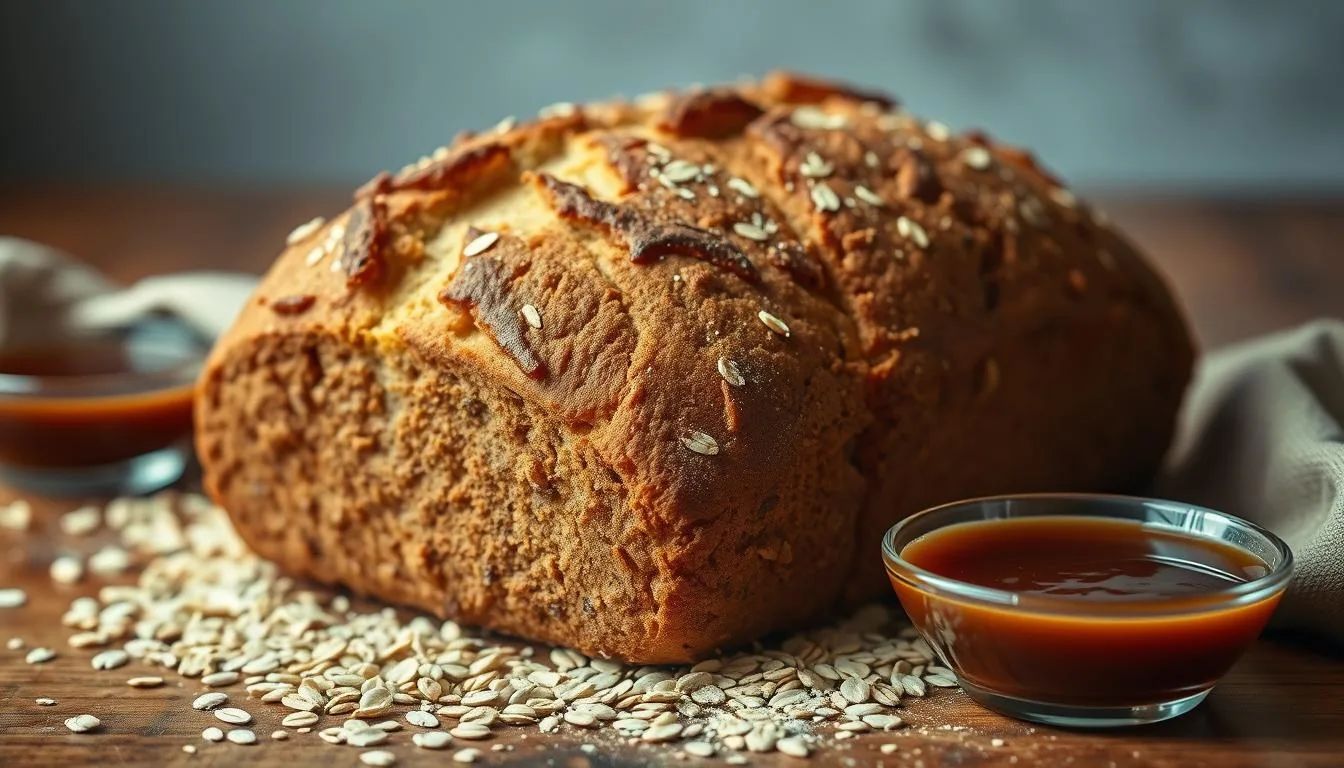Imagine the smell of fresh bread, its golden crust shining. The scent of molasses and oats fills the air. This is the King Arthur Oat Molasses Bread, a classic you’ll love. Discover what sets it apart and makes it truly unique.
Ever wondered what makes this bread stand out? It’s the mix of whole grain oats and blackstrap molasses. This combo makes a loaf that’s both comforting and healthy. Baking it feels like going back in time, connecting with homemade traditions.
Key Takeaways
- Discover the unique blend of whole grain oats and blackstrap molasses that sets this bread apart
- Learn the secrets behind the homestyle appeal and classic flavors of the King Arthur Oat Molasses Bread
- Explore the history and origins of this timeless bread recipe
- Uncover the nutritional benefits of oats and molasses, and how they contribute to the overall health of this bread
- Gain practical tips and techniques for baking the perfect loaf of oat molasses bread at home
Table of Contents
Ready to discover the secrets of this beloved bread? Let’s explore the King Arthur Oat Molasses Bread recipe together!
Introduction to Oat Molasses Bread
I love baking rustic bread loaves that remind me of home. The oat molasses bread is a favorite of mine. It’s like moist rye bread but with a special twist. It’s made with oats and molasses, a classic combo that’s been around for ages.
What Makes This Bread Special?
This bread is special because of its texture and taste. The oats make it hearty and rustic. The molasses adds sweetness and a dark color. Together, they make the bread moist and tender, perfect for spreads and dips.
A Brief History of Oat and Molasses Combinations
Oats and molasses have been together in baking for a long time. Early settlers in North America used them to make nourishing bread. King Arthur Flour helped make this recipe popular, inspiring many to bake it at home.
Ingredients Needed for the Recipe
To bake the perfect oat molasses bread, you’ll need a few key ingredients.
Salt: Brings out and enhances the bread’s overall flavor. These can make the bread even better.
Essential Ingredients for Oat Molasses Bread
- Whole grain oats: The star of the show! High-quality whole grain oats provide fiber, nutrition, and a delightful chewy texture to the bread.
- Blackstrap molasses: This rich, dark molasses adds a deep, complex sweetness that pairs beautifully with the oats.
- King Arthur Flour: A trusted brand known for its consistent, high-performing flours, making it the perfect choice for this recipe.
- Active dry yeast: Essential for achieving the perfect rise and airy crumb.
- Milk or buttermilk: Adds moisture and tenderness to the dough.
- Butter or oil: Helps create a soft, pillowy texture.
- Salt: Enhances the overall flavor of the bread.
Optional Add-ins to Enhance Flavor
While the essential ingredients are the backbone of this oat molasses bread, there are several optional add-ins that can take your loaf to the next level:
- Chopped walnuts or pecans: Adds a delightful crunch and nutty flavor.
- Raisins or dried cranberries: Provide pockets of sweetness throughout the bread.
- Cinnamon or nutmeg: Warm spices that complement the molasses beautifully.
- Crystallized ginger: Lends a subtle hint of spice and a chewy texture.
With these key ingredients and the freedom to experiment with optional add-ins, you’ll be well on your way to baking a truly remarkable oat molasses bread. It’s guaranteed to please your senses and satisfy your palate.
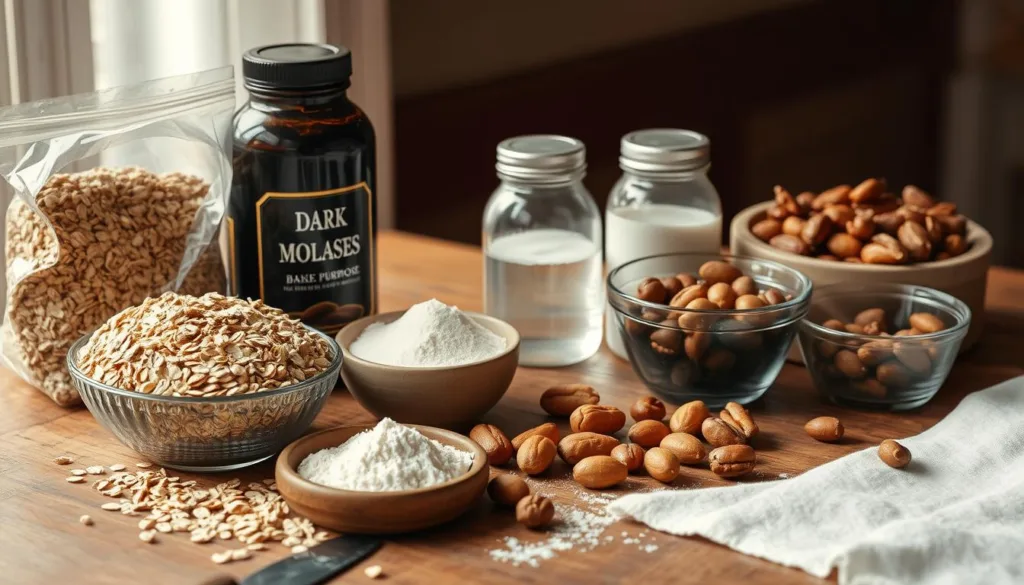
The Importance of High-Quality Ingredients
Quality ingredients are key to baking the perfect oat molasses bread. Pay close attention to the flour and molasses.
Choosing the Right Flour
I highly recommend King Arthur Flour for this recipe. It’s known for its quality and performance in baking. Their whole grain oats flour is perfect, adding a nutty flavor that goes well with blackstrap molasses.
- King Arthur Flour is milled to the perfect texture, ensuring a soft, tender crumb in your final bread.
- The whole grain oats add a satisfying heartiness and boost the overall nutritional value of the loaf.
- Consistent quality means you can rely on consistent results every time you bake this recipe.
Selecting the Best Molasses
For this oat molasses bread, use blackstrap molasses. It adds a depth of flavor that makes the bread special.
- Blackstrap molasses is made from the final boiling of sugar cane, resulting in a more concentrated, less-sweet flavor profile.
- It’s rich in minerals like iron, calcium, and magnesium, providing additional nutritional benefits.
- The dark, almost bittersweet notes of blackstrap molasses balance beautifully with the nutty whole grain oats.
Using King Arthur Flour and blackstrap molasses will make your oat molasses bread the best it can be. It will taste great, feel good, and be good for you.
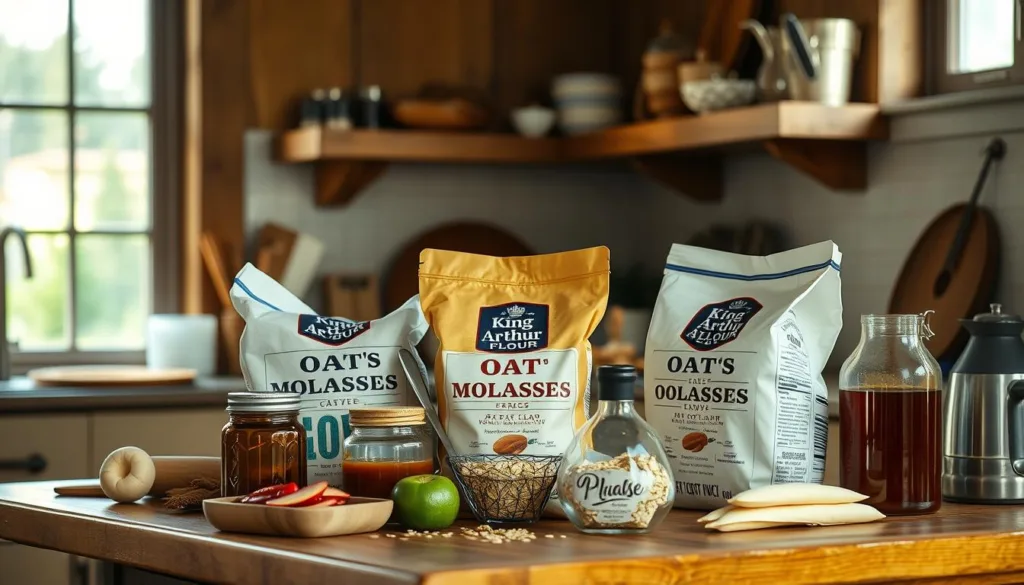
Preparing the Dough
Making the perfect oat molasses bread starts with the dough. Follow a simple step-by-step guide and use some key tips. This will help you make a dough that’s smooth and rustic.
Step-by-Step Dough Preparation
- First, proof the yeast in warm water for about 10 minutes. This lets it activate.
- Next, mix the whole grain oats, all-purpose flour, and a bit of salt in a big bowl. Whisk until they’re evenly spread.
- Make a well in the dry mix and add the yeast mixture, molasses, and warm water. Use a spoon to mix until it’s shaggy.
- Then, knead the dough on a floured surface. Use your palm to push and fold it. Knead the dough for 8-10 minutes until it becomes smooth and elastic.
Tips for a Smooth Dough Consistency
- Adjust the flour and water to get the right texture. The dough should be slightly tacky.
- Add the whole grain oats slowly. Let the dough absorb them before adding more.
- Knead with a steady motion. Use your body weight to fold the dough.
- Keep your surface lightly floured. But don’t add too much flour, or the dough will be dry.
By following these steps and tips, you’ll make a dough that’s ready for shaping. It will be perfect for a delicious oat molasses bread loaf.
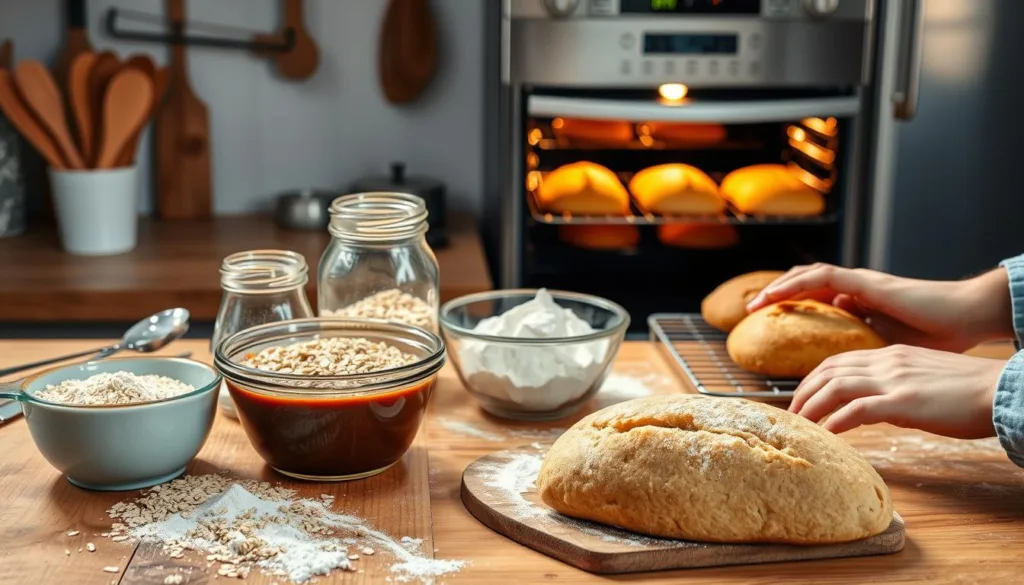
The Role of Yeast in Bread Making
Yeast is a key player in making rustic bread loaves. It turns simple dough into a light, airy, and tasty King Arthur Flour treat. Knowing about yeast types and how to use them is key to baking success.
Active Dry Yeast vs. Instant Yeast
The choice between active dry yeast and instant yeast matters in baking techniques. Active dry yeast needs a proofing step in warm water before adding to dough. Instant yeast can go straight into dry ingredients without proofing.
How to Activate Yeast Properly
- To activate active dry yeast, mix it with warm water (around 110°F) and a bit of sugar. Wait 5-10 minutes for it to bubble and froth.
- After yeast is ready, mix it into your King Arthur Flour dough as the recipe says.
- Right yeast activation is key for a dough that rises well. This makes your rustic bread loaf light and airy.
Learning to activate yeast is a basic baking technique. With practice, you’ll make perfect King Arthur Flour loaves every time.
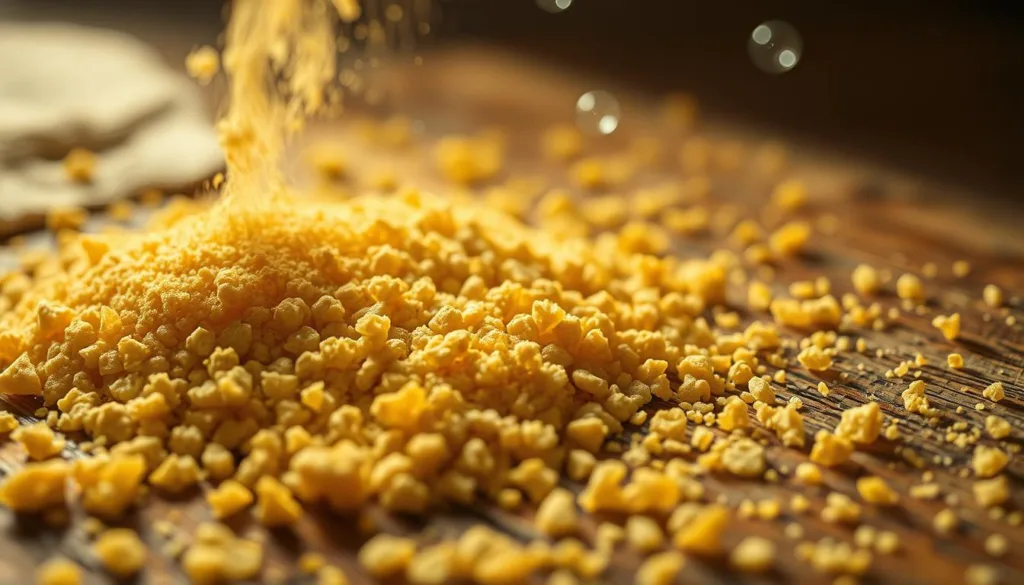
Kneading Techniques for the Perfect Dough
Kneading is key when baking rustic bread loaves with whole grain oats. I’ve tried both hand-kneading and machine-kneading. I’m excited to share the knowledge I’ve gained.
Hand-Kneading vs. Machine-Kneading
Both hand-kneading and machine-kneading can make great baking techniques for your rustic bread loaves. Hand-kneading lets you feel the dough, giving you a hands-on experience. Machine-kneading saves time, especially with whole grain oats that need more mixing.
Kneading until the dough is smooth and elastic is essential. You should be able to stretch a small piece of dough thinly without it tearing.
| Hand-Kneading | Machine-Kneading |
|---|---|
| Allows for a more intuitive feel of the dough | Saves time and effort, particularly with whole grain oats |
| Develops a better understanding of dough consistency | Ensures thorough and even mixing |
| Provides a more hands-on, artisanal experience | Reduces the risk of over-kneading |
Mastering kneading, by hand or machine, will help you make perfect rustic bread loaves with whole grain oats. Look for signs of well-kneaded dough. Your baking will be tasty and fulfilling.
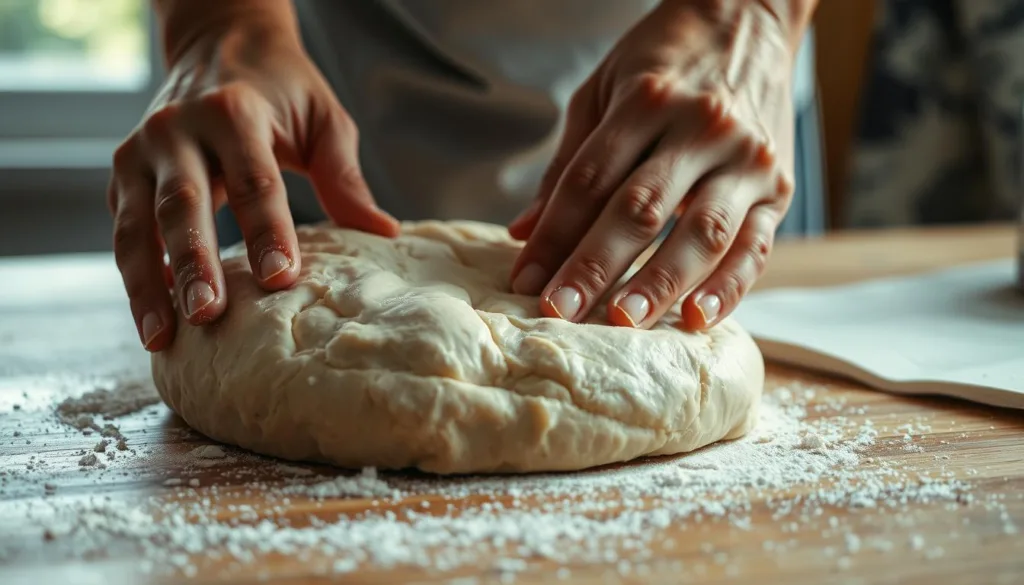
First Rise: Letting Your Dough Rest
The first rise is a key step in baking. It can make or break your rustic bread loaves. For moist rye bread or other classics, letting the dough rest is crucial. Get this right, and you’re on your way to perfect bread.
How Long Should You Let the Dough Rise?
Allow the dough to rise for 1 to 2 hours. This lets yeast work, making the dough soft and airy. Room temperature and yeast strength can change this time, so adjust as needed.
Tips for a Successful First Rise
- Choose a warm, draft-free spot for your dough to rise. Avoid direct sunlight or windows.
- Cover the dough with a damp towel or plastic wrap to prevent a skin.
- Don’t open the container too often. It can disrupt the rise.
- If the dough isn’t rising, try proofing it in the oven with the light on.
Mastering the first rise will help you bake tender, flavorful oat molasses bread. With practice, your baking will get better and better.
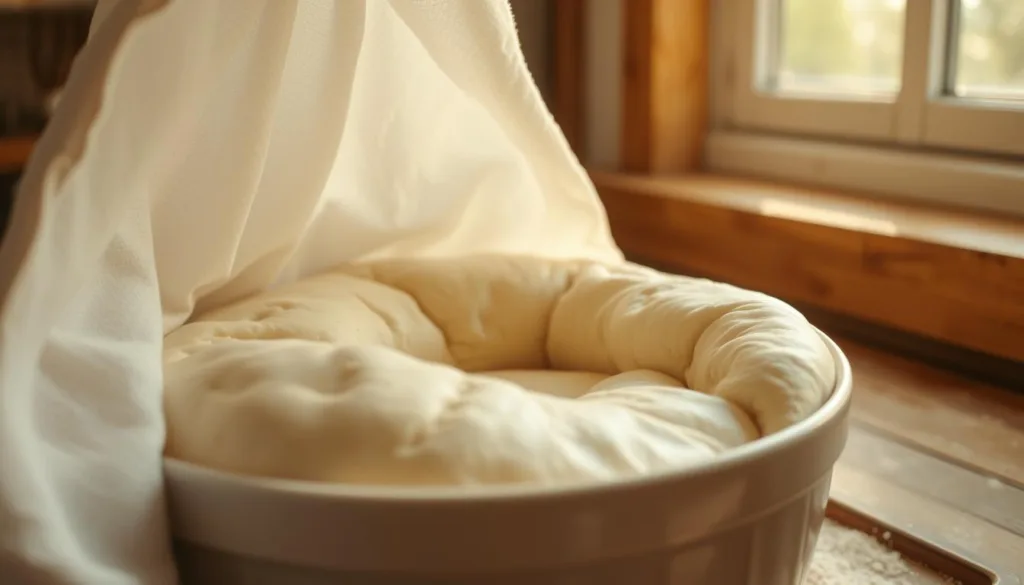
Shaping the Dough
Shaping the dough is key to baking perfect oat molasses bread. The right techniques can turn your King Arthur Flour dough into beautiful rustic loaves. These loaves look great and feel wonderful to eat.
Techniques for Shaping a Loaf
To shape your oat molasses bread dough, start by gently punching it down. This releases air bubbles. Then, use your hands to stretch and fold the dough into a smooth shape.
For a classic loaf, shape it into a tight ball and put it seam-side down in a greased loaf pan. Or, shape it into an oval or oblong for a rustic look. Transfer it to a baking sheet lined with parchment paper.
- Overworking the dough: Handling the dough too aggressively can make it dense and tough. Be gentle when shaping.
- Misshaping the loaf: Uneven shaping can lead to an unevenly baked loaf. Make sure the dough is shaped smoothly and evenly.
- Forgetting to grease the pan: Grease the pan well if baking in one. This helps prevent the bread from sticking and ensures easy removal.
With practice and attention to detail, you’ll get better at shaping oat molasses bread dough. Remember to handle the dough gently and aim for a consistent shape for even baking.
Second Rise: The Final Touch
Baking the perfect loaf of bread needs a second rise. This step makes the dough more flavorful and textured. It turns into a rustic bread loaf that will wow everyone.
How to Ensure Your Bread Rises Well
To get a great second rise, you need the right environment. Here are some tips:
- Keep the dough in a warm, draft-free spot. Try an oven with the light on or a microwave with hot water.
- Cover the dough with a damp towel or plastic wrap to retain moisture.
- Let the dough rise for 30-60 minutes, or until it doubles in size.
- Don’t let the dough over-proof. This can make the bread dense.
Covering the Dough: What to Use
It’s important to cover the dough right. This keeps it moist and prevents a skin from forming. Here are some good options:
- Plastic Wrap: Oil the wrap first to avoid sticking.
- Damp Kitchen Towel: Make sure it’s not too wet.
- Proofing Basket or Bowl: Use one lightly floured to hold the dough.
By using these methods, you’ll make a moist, tasty oat molasses bread. It will be as good as the best rustic and rye breads.
Prepping for Baking
Before we bake our King Arthur Oat Molasses Bread, we need to get ready. We must pick the right baking pan and preheat the oven. These steps are key to making a perfect rustic loaf.
Choosing the Right Baking Pan
Choosing the right pan is important for our King Arthur Oat Molasses Bread. Use a light-colored, metal loaf pan for the best results. Dark pans can make the crust too dark, too fast.
Also, pick a pan with straight sides. This helps the bread keep its rustic shape as it rises.
Preheating Your Oven: Why It’s Crucial
Preheating your oven is a must for rustic bread loaves like our King Arthur Flour bread. It makes the bread rise evenly and get a crisp crust. Preheat your oven to 375°F (190°C) before putting in the dough.
By following these steps, you’ll bake a delicious King Arthur Oat Molasses Bread. It’s sure to impress. Next, we’ll look at the baking process itself!
Baking the Oat Molasses Bread
Baking the perfect oat molasses bread is a fun process. It requires close attention and a few essential techniques. This rustic loaf is moist and tender, making it a delightful homestyle bread.
Ideal Baking Temperature and Timing
Preheat your oven to 375°F (190°C) for the best results. This temperature helps the bread bake evenly. It also gives it a beautiful golden-brown crust, like other rustic breads.
The bread should bake for about 35 to 40 minutes. But, watch it closely because baking times can change. The bread is ready when a toothpick or cake tester inserted into the center comes out clean.
Check for Doneness: What to Look For
- The crust should be a rich, golden-brown color and sound hollow when tapped.
- The internal temperature of the bread should reach 205°F (96°C) to 210°F (99°C) when measured with a digital thermometer.
- The loaf should have a soft, tender crumb that is not doughy or underbaked.
Remember, baking times and techniques can change. This depends on your pan, kitchen humidity, and other factors. Always watch your oat molasses bread closely. Make adjustments as necessary to achieve the perfect result.
Cooling and Storing the Bread
Baking the perfect loaf of rustic bread is just the start. Proper cooling and storage are essential. This keeps your homemade oat molasses bread fresh and tasty for days. It’s great for breakfast or as part of New England baked goods.
Best Practices for Cooling
When your oat molasses bread comes out of the oven, let it cool down first. Put it on a wire rack and wait for at least 30 minutes. This helps the inside set right, so it doesn’t fall apart when you cut it.
Don’t cut into it right away. Waiting a bit will make sure it’s perfectly textured and easy to slice.
Storing Your Oat Molasses Bread
- After cooling, you can store your rustic oat molasses bread at room temperature for up to 4 days. Wrap it tightly in plastic wrap or use a bread box to keep it soft.
- For longer storage, freeze it for up to 3 months. Slice the loaf first, then wrap each slice in plastic wrap or foil. This stops it from drying out or getting freezer burn.
- To thaw frozen slices, let them sit at room temperature or warm them in the oven or toaster. This keeps the bread’s hearty texture and flavor, perfect for busy mornings or sudden gatherings.
By cooling and storing your bread the right way, you can enjoy its rustic bread loaves, hearty breakfast bread, and New England baked goods qualities for days. Share the comforting flavors of this classic recipe with your loved ones. Your hard work will pay off with perfectly preserved slices.
Serving Suggestions
Oat molasses bread is great for many uses. It’s perfect as a hearty breakfast bread. It’s loved by New Englanders and bread fans everywhere. Enjoy it with spreads or as a sandwich base.
Sandwich Ideas with Oat Molasses Bread
The bread’s flavor and texture are perfect for sandwiches. Try it with a grilled cheese for a sweet twist. Or, layer it with turkey, bacon, and avocado for a tasty club sandwich.
Pairing with Spreads and Dips
- Spread peanut butter or almond butter for a hearty breakfast.
- Top it with cream cheese or ricotta and fresh berries for a sweet contrast.
- Dunk it in hummus or baba ganoush for a tasty snack.
This oat molasses bread will be a favorite in your kitchen. It’s delicious and healthy for any time.
Nutritional Benefits of Oat Molasses Bread
Our hearty breakfast bread is a mix of whole grain oats and blackstrap molasses. It’s not just tasty. It’s also full of health benefits. This makes it a great choice for your morning meal.
High Fiber and Nutrient Content
Whole grain oats are known for their fiber. Our recipe has 4 grams per serving. This fiber is good for your digestion and keeps you full.
It also helps your heart stay healthy. Plus, whole grain oats have vitamins, minerals, and antioxidants. These support your overall health.
The Health Perks of Molasses
Blackstrap molasses is a key ingredient in our hearty breakfast bread. It’s not just sweet. It’s also rich in iron, calcium, and magnesium.
Research shows it’s good for your bones and blood sugar. It might even fight inflammation.
By mixing whole grain oats with blackstrap molasses, we get a hearty breakfast bread. It tastes great and is good for you. Enjoy it with a balanced meal to start your day well.
Troubleshooting Common Issues
Baking the perfect rustic oat molasses bread can be tough, even for experts. But, with some troubleshooting, you can fix common problems. This way, you can enjoy the tasty results of your baking with King Arthur Flour.
Steps to Take If Your Bread Doesn’t Rise
If your bread doesn’t rise, there are a few reasons. First, make sure you activated the yeast right. Check the yeast’s expiration date too. Also, your kitchen’s temperature and humidity can affect rising.
Try adjusting your kitchen to help your dough rise better.
Fixing Dense or Crumbly Bread
A dense or crumbly bread can be a problem. But, there are solutions. Overworking the dough can make it dense. So, knead carefully and don’t overdo it.
If your dough is too wet, it might be crumbly. Next time, adjust the flour and liquid ratio to get the right dough.
Baking the perfect oat molasses bread is an art. It might take practice and trying different things. But, with these tips and King Arthur Flour’s ingredients, you’ll get better at baking rustic bread loaves.
Final Thoughts on Baking Oat Molasses Bread
I love rustic bread loaves and New England baked goods. The King Arthur oat molasses bread recipe stands out. It fills my home with a delicious smell. It brings back memories of cozy times with loved ones.
My Personal Experience with This Recipe
I found this recipe a few years ago. The moment I took it out of the oven, I knew it was special. The oats and molasses mix creates a unique flavor. It’s perfect with many meals and snacks.
Encouraging Readers to Try It Out
If you love the oat molasses bread recipe king arthur, or want to try a new rustic bread loaves recipe, try this. It’s a great example of New England baked goods. I promise you’ll love it. So, put on your apron, preheat your oven, and enjoy baking bliss.
Seasonal food – Breakfast – Lunch – Dinner

